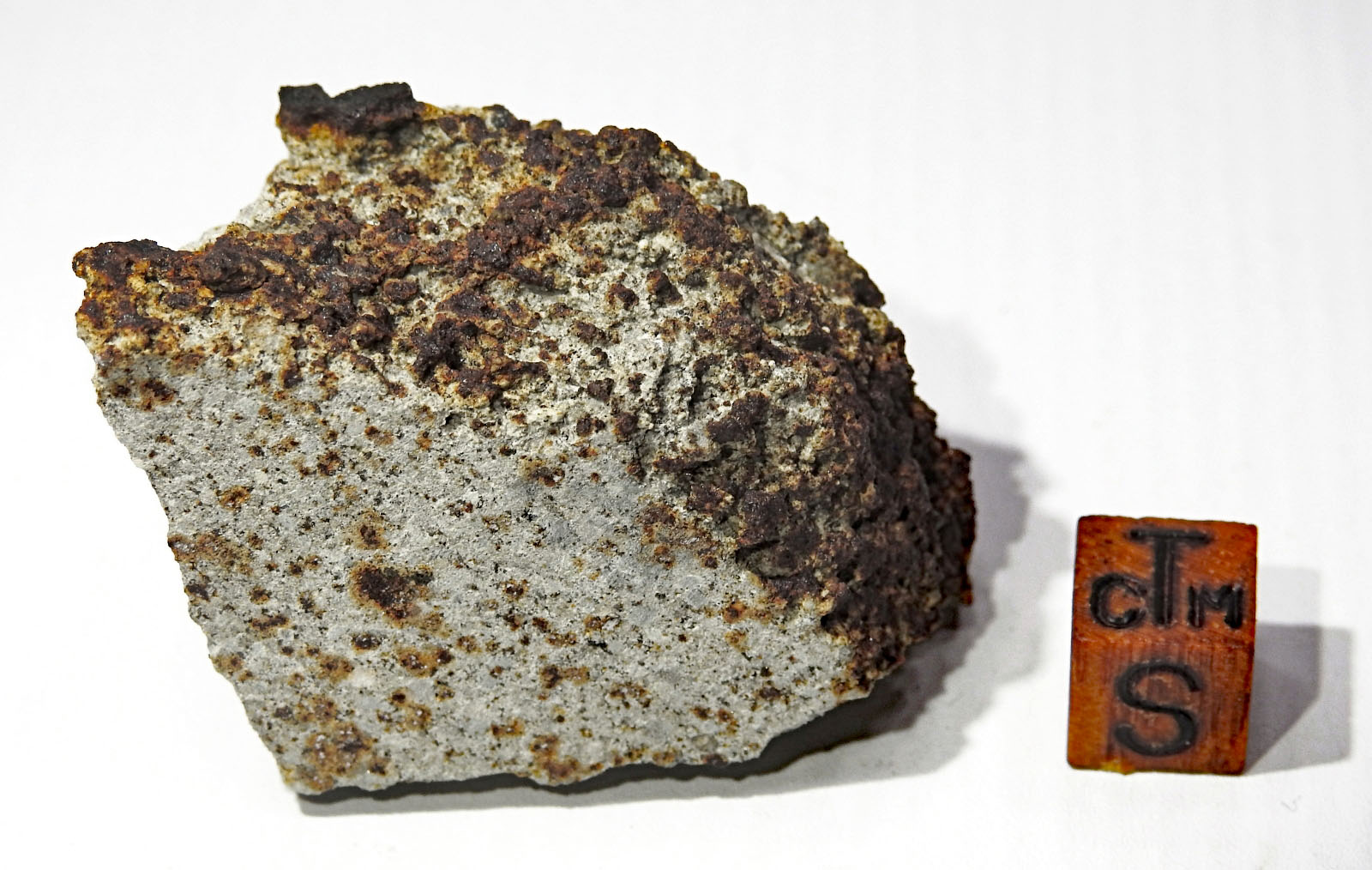|
Roll Overs:
#1
#2
#3
#4
#5
#6
#7
#8
|

|
|
Photos by Steve Brittenham. Copyright (c) Steve Brittenham.
|
66.4 grams. L6
TKW 407 kg. Fall not observed. Found 1976 or 1977 in Antarctica.
The MetBul tells us:
The Official Name is Allan Hills A76009. The Official Abbreviation is ALHA76009. This meteorite may also be called Allan Hills 76009 (ALH 76009) in publications.
  
Steve writes:
Meteorites fall over Antarctica at a rate only about 60% of that at the equator, and its extreme weather conditions and international protections result in significantly fewer people searching there. Yet despite that, Antarctica has still produced two-thirds of all meteorites found to date (interestingly enough, by 1993 – before the flood of African meteorites began in the latter part of the 1990s – that ratio was closer to 85%, with over 15,000 meteorites collected in Antarctica, compared to only about 2600 around the rest of the world).
Like the dry heat of the northwest African deserts, sub-zero temperatures at the poles also retard meteorite weathering. Similarly, the occasional dark meteorite is quite easy to spot against either the light desert sands or the white Antarctic ice. But unlike the deserts, Antarctica has unique “stranding zones” that form where Transantarctic Mountain ranges obstruct the seaward flow of the East Antarctic icesheet. There, gravity-propelled katabatic winds remove large amounts of ice and snow to create dense lag deposits. Researchers happening across these spots often find dozens or even hundreds of exposed meteorites mixed with terrestrial rocks in areas smaller than a football field.
The first Antarctic meteorite was discovered during the 1911-14 Douglas Mawson Australasian Antarctic Expedition. Between 1961 and 1964, an additional three meteorites were found by Russian geologists near Novolazarevskaya Station and by USGS geologists in the Thiel and Neptune Mountains. In 1969, Japanese explorers discovered another nine meteorites upstream from the Yamato Mountains, and by 1975 they had increased their finds by another 982. Because of these successes, the National Science Foundation’s ANtarctic Search for METeorites (ANSMET) was founded, with their first joint search for meteorites occurring in the 1976-77 season.
Allan Hills 76009, or more simply ALH 76009 – was one of the first Antarctic meteorites collected by ANSMET. It was found west of Allan Nunatak during 10-15 meter helicopter overflights of the edge of Victoria Land’s Antarctic Polar Plateau (the area is also known as Allan Nunatak No. 9 or Allan Hills No. 9, the latter being the namesake for the meteorite).
ALH 76009 is, like most Antarctic finds, a stone meteorite (only about 0.5% of Antarctic meteorite finds are irons – compared to 5% outside of Antarctica – because irons are heated more from the sun and hold that heat better, causing them to melt the ice underneath and burrow down during the constant sunlight of the summer months). ALH 76009 was large at 407 kg, and according to NASA’s Antarctic meteorite “bandsaw list”, just under 140 kg (34.3%) is still available for study.
But while ALH 76009 is an otherwise common L6, it’s rare in being one of only a few Antarctic meteorites made available to the public. In 1959, several countries signed a treaty declaring Antarctica a "Land of Science” to be used for strictly non-commercial scientific and peaceful purposes. Because meteorites were not explicitly addressed by language protecting its flora and fauna, a few Antarctic meteorites – including ALH 76009 – were made legally available to the public before revised international laws prohibited their subsequent private acquisition or sale.
The piece shown in the first six of the accompanying photos weighs 66.4 grams; the last two photos are 3D crossed-eyes and red-cyan magnified views of a small fragment with fusion crust that broke off of the 66.4 gram mass. |
Click to view larger photos
#1
#2
#3
#4
#5
#6
#7
#8
|
Found at the arrow (green or red) on the map below
|
|
| |
Brant
3/16/2021 12:26:54 AM |
Everyone knows the ironeatingvoracious icerabbit selectively consumes ferric stones. I*m surprised they found any irons there at all. |
Tracy Latimer
12/21/2020 2:11:59 PM |
One of my very few Antarctic meteorites! |
Steve Brittenham
12/20/2020 6:21:41 PM |
Thanks, Jason. I appreciate the thoughts. And I think your point about why folks find more iron meteorites than stone ones outside of Antarctica makes a lot of sense! |
Jason Utas
12/20/2020 5:43:54 PM |
The study suggesting that iron meteorites sink in Antarctic ice (Evatt et al., 2016) used an ambient temperature of -1*C for their experiments - just below freezing. Actual daily high temperatures on Antarctic ice sheets in the summer are usually no higher than ~ -18*C, well below the freezing point of water.
It is much more difficult to melt ice at -18*C than it is at 0 to -1*C. The authors do not justify that experimental parameter anywhere in their paper, and the other works they cite for their parameters, such as Folco et al. (2002), describe similar low temperatures. Given that even relatively large iron meteorites like QUE 99001 have been found on the surface of Antarctic ice, I would be cautious about accepting the conclusions of Evatt et al.
There is an obvious reason for irons to be more commonly found outside of Antarctica: to laymen, masses of solid metal are much more easily recognized as anomalous objects compared to ~any type of stony meteorite. |
John Lutzon
12/20/2020 10:30:19 AM |
Thanks Steve, Some of which I did not know. |
| |
|